
Valencia is the capital of the province and autonomous community of the same name in Spain. It is the third-most populated municipality in the country, with 807,693 inhabitants within the commune, 1,582,387 inhabitants within the urban area and 2,522,383 inhabitants within the metropolitan region. It is located on the banks of the Turia, on the east coast of the Iberian Peninsula on the Mediterranean Sea.
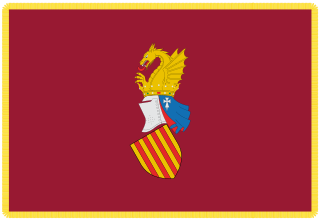
The Generalitat Valenciana is the generic name covering the different self-government institutions under which the Spanish autonomous community of Valencia is politically organized.
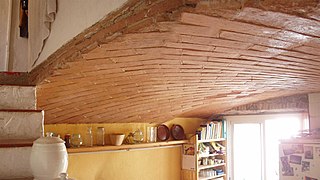
The Catalan vault, also called thin-tile vault, Catalan turn, Catalan arch, boveda ceiling, or timbrel vault, is a type of low brickwork arch forming a vaulted ceiling that often supports a floor above. It is constructed by laying a first layer of light bricks lengthwise "in space", without centering or formwork, and has a much gentler curve than most other methods of construction.

The University of Valencia, shortened to UV, is a public research university located in the city of Valencia, Spain. It is one of the oldest universities in Spain, and the oldest in the Valencian Community. It is regarded as one of Spain's leading academic institutions.

The Archdiocese of Valencia is a Latin Church diocese of the Catholic Church located in north-eastern Spain, in the province of Valencia, part of the autonomous community of Valencia. The archdiocese heads the ecclesiastical province of Valencia, with authority over the suffragan dioceses of Ibiza, Majorca, Minorca, Orihuela-Alicante and Segorbe-Castellón. The archbishops are seated in Valencia Cathedral. Enrique Benavent Vidal succeeded Cardinal Antonio Cañizares Llovera as the Archbishop of Valencia in 2022.

La Pobla Llarga is a municipality in the comarca of Ribera Alta in the Valencian Community, Spain. Well known of the orange growth and its flourishing commerce in the 19th and 20th centuries. Currently, its inhabitants live basically on agriculture and the service sector.
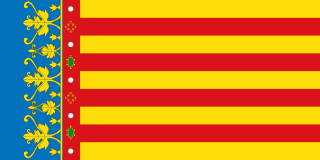
The Valencian Community is an autonomous community of Spain. It is the fourth most populous Spanish autonomous community after Andalusia, Catalonia and the Community of Madrid with more than five million inhabitants. Its homonymous capital Valencia is the third largest city and metropolitan area in Spain. It is located along the Mediterranean coast on the east side of the Iberian Peninsula. It borders Catalonia to the north, Aragon and Castilla–La Mancha to the west, and Murcia to the south, and the Balearic Islands are to its east. The Valencian Community is divided into three provinces: Castellón, Valencia and Alicante.
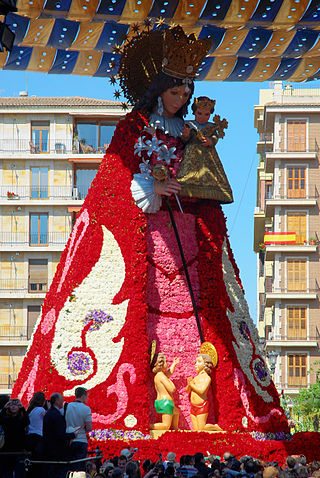
Our Lady of the Forsaken is a Catholic invocation of the Virgin Mary. She is the patroness of Valencia and one of seven patrons of the Autonomous communities of Spain. She appears with a lily in one hand and in the other, she carries the baby Jesus who bears the cross in his arms. Her posture is characterized by a slight forward tilt, and hence, she is known affectionately as the Geperudeta (hunchback) of València. Her image is housed in the 'Basilica de la Mare de Déu dels Desamparats'.
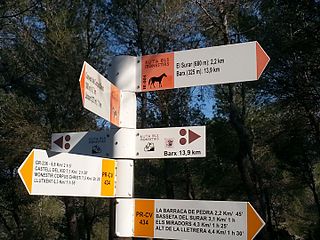
The Route of the Monasteries of Valencia (GR-236) is a religious and cultural route that connects five monasteries located in central region of the Province of Valencia,, in Spain. The Route was inaugurated in the year 2008.

The president of the Valencian Government is the head of the Generalitat Valenciana, the government of the Spanish autonomous community of Valencia. The president is chosen by the Valencian parliament, the Corts Valencianes.

The Ara Christi Charterhouse, or the Cartuja de Ara Christi, is a former Carthusian monastery located just outside the town of El Puig in the province of Valencia, Spain. The site now includes a hotel and utilizes the facilities for functions.
Felipe Maria Garin Ortiz de Taranco was a Spanish writer, researcher and Academician of art.
Josep Palomero i Almela is a Valencian linguist and vice-president of the Valencian Language Academy.

Valencian Art Nouveau is the historiographic denomination given to an art and literature movement associated with the Art Nouveau in the Valencian Community, in Spain.

The first government of Ximo Puig was formed on 30 June 2015, following the latter's election as President of the Valencian Government by the Corts Valencianes on 25 June and his swearing-in on 28 June, as a result of the Socialist Party of the Valencian Country (PSPV–PSOE) and Commitment Coalition (Compromís) being able to muster a majority of seats in the Parliament with external support from We Can (Podemos) following the 2015 Valencian regional election. It succeeded the Fabra government and was the Valencian Government from 30 June 2015 to 17 June 2019, a total of 1,448 days, or 3 years, 11 months and 18 days.

The Ramon Llull Award is an honor awarded annually by the Government of the Balearic Islands to persons or entities of the Balearic Islands that have excelled in any field. It was established in 1997 by Decree 3/2014.

The second government of Ximo Puig was formed on 17 June 2019, following the latter's election as President of the Valencian Government by the Corts Valencianes on 13 June and his swearing-in on 15 June, as a result of the Socialist Party of the Valencian Country (PSPV–PSOE) emerging as the largest parliamentary force at the 2019 regional election. It succeeded the first Puig government and was the Valencian Government from 17 June 2019 to 19 July 2023, a total of 1,493 days, or 4 years, 1 month and 2 days.
International Sample Fair of Valencia or, as a trademark, Feria Valencia is the oldest institution organizing fair events in Spain, its year of foundation being in 1917. Recently remodeled and expanded, the work of architect José María Tomás Llavador, It constitutes one of the most important within the European circuit.






















